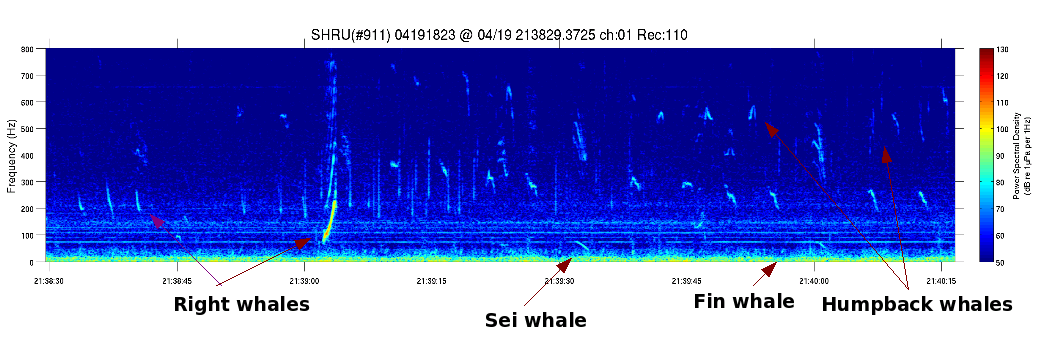|
|
Localization of Right Whales in Cape Cod BayCape Cod Bay is an important seasonal habitat for endangered North Atlantic right whales (Eubalaena glacialis). In April 2011, 25 continuous days of acoustic, oceanographic and visual observations were made in Cape Cod Bay for the purpose of collecting endangered right whale vocalizations. The field work was designed to test and validate new advanced localization techniques developed here at WHOI for long-term, long distance detection, tracking and identification of baleen whales from a single site. We selected Cape Cod Bay as our testing site since this area is one of the critical habitats of the endangered North Atlantic right whale. Studies have found that multiple species of marine mammals, especially right whales, visit Cape Cod Bay during this time of year to forage on zooplankton.
Right whales also don't typically react to shipping noise, and consequently are prone to ship strikes because of their surface feeding habits, and because they travel relatively slow in the water (9.3 km/h). It has become a priority to study the behavior of these whales and track their location so that adequate measures can be taken to avoid ship strikes, and maintain their population.
Below is an image of a whale (left) and its migration path (right, courtesy of Oceanus Magazine 2004). 
 In order to perform localizations using both normal mode back-propagation and triangulation techniques, four hydrophone arrays were placed in Cape Cod Bay. Three of these were vertical line arrays named SHRU's (Several Hydrophone Receiving Units) and one was a Webb array and a horizontal component to complete a L-shaped array to be used for localization. Each vertical hydrophone array consisted of two SHRU electronic packages, and each SHRU contained 4 hydrophones making a total of 8 hydrophones per mooring.
The L-shaped array measures the sound arrival times that will be used to determine depth, direction, and range of a sound source in the water column. This means that the back-propagation technique gives more information about the location of the sound source in comparison to the triangulation method. The new method gives a three dimensional location of the animal as well as the sound source signature, whereas most triangulation methods only give location.
The following image shows our experimental design.

Sounds of the many whale species in Cape Cod Bay in the SpringFour subsurface moorings were deployed in Cape Cod Bay in the Spring of 2011 to record and localize the endangered right whale. But we also recorded fin whales, sei whales, and humpback whales all in the vicinity at the same time.
 Interview with the Principal Investigators | |||
Copyright ©2007 Woods Hole Oceanographic Institution, All Rights Reserved, Privacy Policy. |

